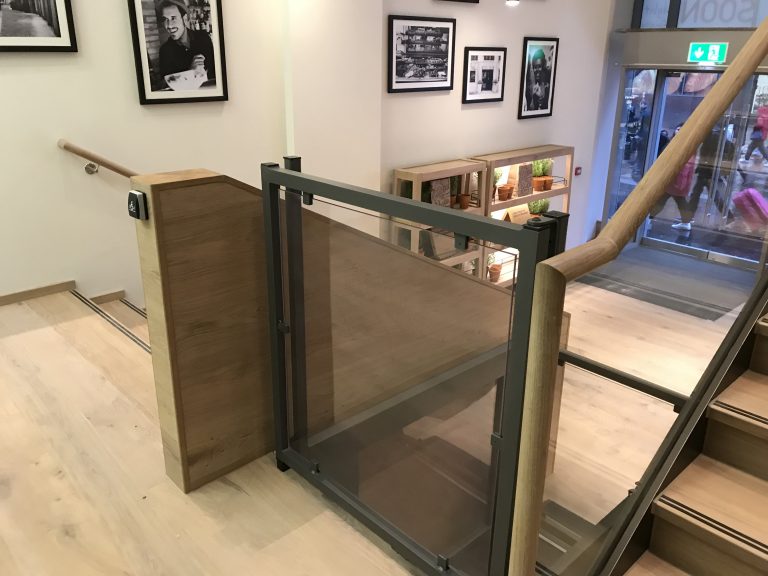How do platform lifts work?
Contents |
[edit] Introduction
Platform lifts allow a platform to rise up and down and are typically used for disabled access. They can be installed indoors or outdoors and offer access where passenger lifts cannot be installed. A platform lift can take a number of different forms, but primarily they are used in low-rise buildings due to potential building restrictions. They are cost-effective, easy to install.
[edit] Types of platform lifts
[edit] Step lift (vertical platform lift)
These lifts can be installed on the side of a step or steps to help the user to access another level whilst leaving the steps clear for other users. They provide travel up to one metre and can be used internally or externally.
[edit] Incline stair lift
These lifts enable wheelchair users to access the next storey using a stairlift with a level platform. The platform is fixed to a diagonal runner at the wall side of the staircase. They can be installed virtually anywhere, indoors and outdoors, and can be placed in straight or curved staircases with several landings or turns.
[edit] Vertical platform lift
Vertical platform lifts are similar to traditional enclosed lifts; however, they do not have the same capacity, speed or travel height as commercial lifts, making them better suited to domestic dwellings or smaller commercial buildings. The lift is self-supporting and requires limited building alterations compared with traditional lifts. It is secured to a wall and can be versatile in terms of design.
[edit] How do they work?
There are three main types of platform lift drive systems, each suited to different specifications, and each with their own advantages and disadvantages. Modern platform lifts are operated using electronic controls which send signals to a central processor unit. This unit initiates the motors or pumps to move the platform between levels.
[edit] Hydraulic drive system
For this system, the lift platform is attached to a hydraulic ram. To move the lift, hydraulic fluid is pushed via a pump from a central reservoir into the ram. The pressure extends the ram and causes the lift to rise; the flow is then reversed to lower the lift.
The main disadvantage to this system is that the mechanism requires extra space, and sometimes the hydraulic fluid can give off an odour in hot weather.
[edit] Screw and nut drive system
This lift utilises a steep screw pole which runs the length of the shaft. A motor on the platform drives a nut attached to the screw. When the motor turns the nut, the lift will go either up or down, depending on the direction it is turning. Installing this system often requires a supporting wall, especially on longer travel lifts, to stabilise the unit.
The disadvantage to this system is that the thread on the screw and drive nut is susceptible to wear and tear, requiring routine lubrication, often by a self-lubricating system.
[edit] Encapsulated chain drive system
The final system is the encapsulated chain drive system. This system makes use of a chain which is encased in a highly-durable polyurethane plastic casing which guides the chain and ensures it does not slip. A motor and gearbox turn a driveshaft which the chain is attached to. As the driveshaft rotates, the chains are either pulled or pushed, moving the platform up or down.
The advantage of this system is that its durability allows a much longer guarantee on the drive system.
--Nathan Massey 09:25, 20 Jul 2018 (BST)
[edit] Related articles on Designing Buildings Wiki
Featured articles and news
Retired firefighter cycles world to raise Grenfell funds
Leaving on 14 June 2025 Stephen will raise money for youth and schools through the Grenfell Foundation.
Key points for construction at a glance with industry reactions.
Functionality, visibility and sustainability
The simpler approach to specification.
Architects, architecture, buildings, and inspiration in film
The close ties between makers and the movies, with our long list of suggested viewing.
SELECT three-point plan for action issued to MSPs
Call for Scottish regulation, green skills and recognition of electrotechnical industry as part of a manifesto for Scottish Parliamentary elections.
UCEM becomes the University of the Built Environment
Major milestone in its 106-year history, follows recent merger with London School of Architecture (LSE).
Professional practical experience for Architects in training
The long process to transform the nature of education and professional practical experience in the Architecture profession following recent reports.
A people-first approach to retrofit
Moving away from the destructive paradigm of fabric-first.
International Electrician Day, 10 June 2025
Celebrating the role of electrical engineers from André-Marie Amperè, today and for the future.
New guide for clients launched at Houses of Parliament
'There has never been a more important time for clients to step up and ...ask the right questions'
The impact of recycled slate tiles
Innovation across the decades.
EPC changes for existing buildings
Changes and their context as the new RdSAP methodology comes into use from 15 June.
Skills England publishes Sector skills needs assessments
Priority areas relating to the built environment highlighted and described in brief.
BSRIA HVAC Market Watch - May 2025 Edition
Heat Pump Market Outlook: Policy, Performance & Refrigerant Trends for 2025–2028.
Committing to EDI in construction with CIOB
Built Environment professional bodies deepen commitment to EDI with two new signatories: CIAT and CICES.
Government Grenfell progress report at a glance
Line by line recomendation overview, with links to more details.
An engaging and lively review of his professional life.
Sustainable heating for listed buildings
A problem that needs to be approached intelligently.
50th Golden anniversary ECA Edmundson apprentice award
Deadline for entries has been extended to Friday 27 June, so don't miss out!
CIAT at the London Festival of Architecture
Designing for Everyone: Breaking Barriers in Inclusive Architecture.
Mixed reactions to apprenticeship and skills reform 2025
A 'welcome shift' for some and a 'backwards step' for others.





























